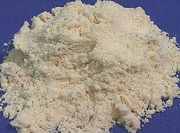Week 3
Protein Sources
|
 |
 |
Instructions for listening to audio clips
- Download the QuickTime
Player to listen to the audio files.
- Read the QuickTime
Instructions for installation help.
- Download the RealPlayer to listen to the audio files
- Instructions are on the RealPlayer download page
Protein Supplements of Animal Origin - Milk-Based Products
Audio for this section is not available.
- Text Transcript
Follow along...
- Origin
- Milk and milk processing operations
- Nutritional value
- Superior
- Good source
- Protein content
- Essential amino acids
- Minerals
- Vitamins
- Lactose (sugar)
- Low in fiber
- Low in vitamin D and iron
- Palatable and digestible
- Marketed
- Liquid, semisolid, and dried products
- Respective DM contents 10, 30, 90%
- Cost limits use as animal feed
- Dried, whole milk
- Excellent feedstuff
- Figure 7.4 – Dried milk

- Nutritional value
- Minimum milk-fat 26%
- Maximum water 8%
- CP 25% (AF basis)
- Limited use
- Skimmed milk
- Liquid, condensed, and dried
- Nutritional value
- Compared to whole milk
- Higher in protein, sugar, and minerals
- Lower in vitamin A
- Liquid
- Condensed
- Dried
- Feeding
- Monogastrics and ruminants
- Value varies with age, ration, price, and amount fed
- Buttermilk
- Liquid, condensed, and dried
- Nutritional value
- Similar to respective skimmed milk
- Condensed
- Minimum solids 27%
- CP 11% (AF basis)
- Dried
- Minimum solids 92%
- CP 32% (AF basis)
- Cheese rind or cheese trimmings
- Cheese with most of fat removed
- Nutritional value
- CP app. 50% (AF basis)
- Fat app. 20% (AF basis)
- Additional products include casein, dried hydrolyzed casein, dried milk
albumin, dried milk protein, and dried whey protein concentrate
|
 |
 |
|

